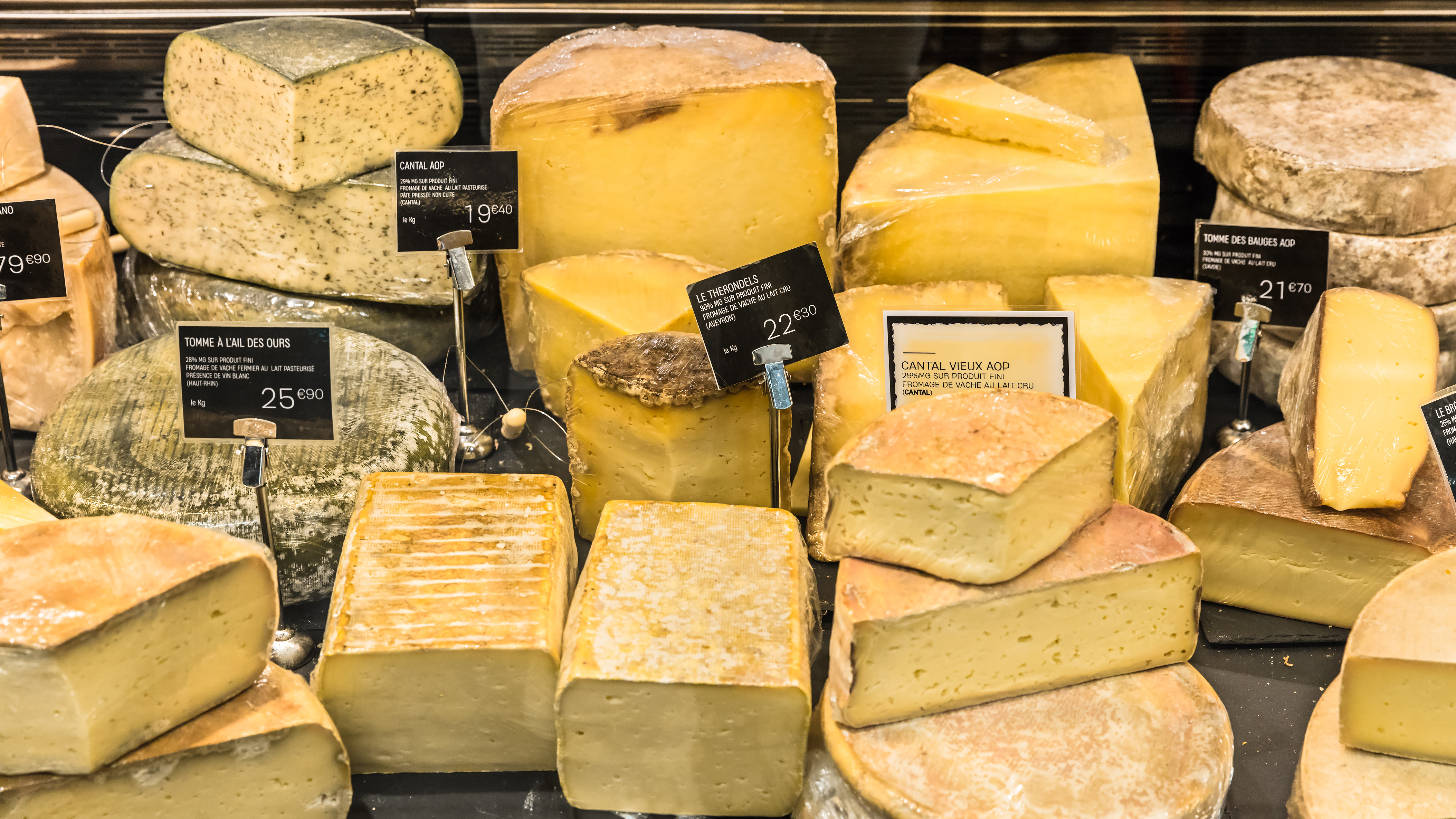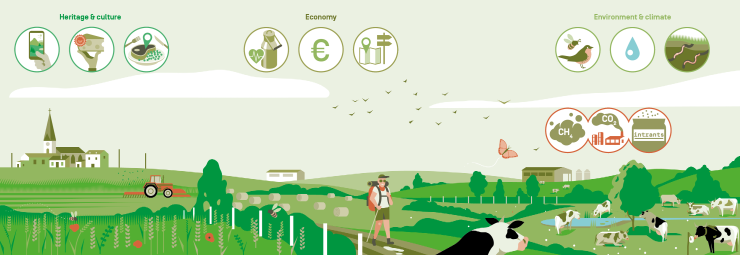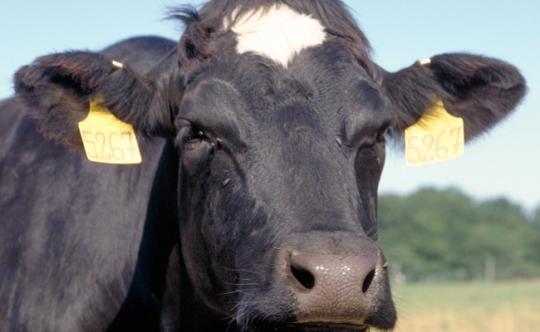Ressources dossier
AgroecologyMeeting economic demands without increasing environmental impacts
Published on 19 January 2023
At the global scale, cow feed costs represent 65% of milk production costs, according to the report World mapping of animal feeding systems in the dairy sector (FAO, IDF, IFCN, 2014). Consequently, farms must deal with fluctuating input prices, particularly those of concentrates, which leads to variability in milk’s cost price. However, the money that farmers receive depends on the contracts they have established and is set by the milk collection and processing industries. It is shaped by supply and demand within the highly competitive global milk market, even if only 9% of production is imported/exported, according to the Centre national interprofessionnel de l'économie laitière (CNIEL).
The global market determines
product profitability
Thus, while the dairy industry’s annual sales amount to nearly 50 billion euros, there are dramatic disparities in farmers’ incomes and profits. “This phenomenon is pronounced within the European Union. As there are no customs duties, all of the EU’s farmers are in direct competition with each other, and the largest exporting country sets prices”, explains Vincent Chatellier, an economist who studies agricultural structures, markets, resources, and regions (INRAE Centre of Brittany-Normandy). On April 1, 2015, the Common Agricultural Policy (CAP) ended dairy quotas, a policy tool that had helped limit each member state’s output.
The Common Agricultural Policy (CAP) ended dairy quotas, a policy tool that had helped limit each member state’s output.
This shift marked the end of guaranteed purchase prices for producers. Some countries, such as Ireland, Germany, and the Netherlands, responded by producing more dairy products for export, which has led to overproduction and lower prices. “France has chosen to maintain its diverse production methods and regions but has consequently lost market share in Europe”, says Vincent Chatellier.
Although France remains the number two producer in Europe, with a stable output of around 25.1 billion litres (CNIEL, 2020), profitability varies substantially among French dairy farms. Conventional dairies frequently face sudden market shifts and sometimes sell at a loss. In contrast, farms operating under certain certification schemes (PDO cheeses, organic milk) or labelling regimes (e.g., C'est qui le Patron, Lait de montagne, Lait de foin, Lait de nos régions) often benefit from greater stability.

Contrasting environmental impacts
In 2010, EU dairy production generated 0.05% of global emissions of greenhouse gases.
The intensification of dairy farming has required ever growing quantities of inputs (e.g., fuel oil, fertiliser, commercial feed), leading to greater environmental impacts. In 2010, EU dairy production generated an equivalent of 176-241 million tons of CO2, which represents 0.05% of global emissions of greenhouse gases (GHG1, CH4, N2O and CO2). Farms are key GHG sources because they utilise ruminant livestock, apply petrochemical fertilisers, produce food, and consume energy. Livestock farming specifically contributes because it relies on imported soybean oil cakes, which improve the protein content of the animals’ diets, based as they are on maize silage rations. Such provokes land use changes that harm biodiversity and ecosystems. In some areas, animal densities are high, grazing is poorly managed, and manure is applied too frequently. Thus, dairy farming can contribute to excessive levels of nitrogen and phosphorus fertilisation.
Such results in the pollution of rivers and phreatic zones, a phenomenon that continues despite regulatory efforts, notably the 1991 EU Nitrates Directive. The latter's effects remain mixed. However, in areas where it is still practiced, ruminant grazing helps preserve permanent or sown grasslands.
1. Direct and indirect emissions, percentage calculated based on data from Rôles, impacts et services issus des élevages en Europe, 2016.

↑
Grass-based dairy farming: services and impacts. While still responsible for net GHG emissions, grass-based livestock systems reduce levels of petrochemical inputs, which are polluting and energy inefficient. Grazing thus helps preserve ecosystems and fosters cultural identity at the regional level (e.g., gastronomy, artisanship, landscapes). With proper public regulation and private local management, these practices are proving to be profitable for the agricultural and tourism industries.
In addition to boosting the attractiveness of regional landscapes, grazing has other benefits. By maintaining grasslands, it is possible to limit soil erosion, regulate water flows, and cleanse mineral and organic pollutants. “Grazing can also reduce the net GHG emissions released by livestock farming. Grasslands are almost as effective as forests at sequestering carbon in the soil”, explains Luc Delaby, an animal husbandry scientist in the Joint Research Unit for the Physiology, Environment, and Genetics for the Animal and Livestock Systems (PEGASE) at the INRAE Centre of Brittany-Normandy. Hedges, grassy banks, and the associated bocages preserve regional biodiversity by creating habitat for wild flora, wild fauna, and microorganisms, which all play a role in various ecological cycles. They also contribute to regional resilience to climate change.
Animal welfare
In 2019, 94% of Europeans considered animal welfare to be important and stated that it influences their purchasing decisions.
Research has shown that farm animals are sentient beings, a fact that has been acknowledged by French and European legislators (French Rural Code, French Civil Code, Treaty of Amsterdam). Sentient animals perceive their environment to varying degrees via emotional and sensory experiences (sight, hearing, smell, taste, touch). The degree of sensitivity varies among species and individuals. Often, animal welfare is described in terms of the Five Freedoms, which focus on well-being as it relates to physiological, environmental, health, behavioural, and psychological conditions. These freedoms are described in terms of results rather than methods.
For example, cows must experience freedom from prolonged hunger or thirst. They must also be protected against excessively high temperatures (e.g., be housed in a ventilated facility, have access to shade). At temperatures above 25°C, cows experience thermal stress. Indoor and outdoor environments need to be designed so as to allow animals to move around freely and to lie down as necessary. These facets of animal welfare are quantifiable and thus easy to characterise. Societal expectations around animal welfare are growing ever greater.

In 2019, 94% of Europeans considered this issue to be important and stated that it influences their purchasing decisions (source: Eurobarometer). “Grazing is viewed positively by society. People associate it with more natural production systems and perceive it as improving animal welfare”, says Luc Delaby. However, it is essential to consider how animals experience grazing rather than simply adopting an anthropomorphic perspective. Scientists and industry stakeholders are thus seeking to develop environments and conditions that allow animals to express species-specific behaviours that promote well-being: social interactions, dietary choices, and educating their young. However, whether at the level of the farm or the globe, it is challenging to strike the right balance between profits, environmental impacts, and animal welfare.
Antibiotics and anti-parasitics: how do we reduce usage?
Ensuring animal health is one of the five essential freedoms and often involves the use of antibiotics and antiparasitics. However, dosage levels that are excessive or insufficient can lead to the emergence of resistant bacteria and/or parasites as well as to environmental pollution. Indeed, France’s first Ecoantibio Programme (2012–2017) encouraged stakeholders to take a preventive rather than a curative approach. Such involves adopting good hygiene and breeding practices.
The use of these products has declined 37% thanks to farmers increasing the cleanliness of their facilities, vaccinating their animals, and targeting sick individuals rather than entire herds for isolation and treatment. Unfortunately, this concern is not shared by all other countries, especially those that still allow the use of antibiotics as “growth promoters”. This practice was banned in the EU in 2006 but remains authorised in the Americas and China.
Bundles of services
To promote progress, scientists have proposed thinking in terms of bundles of services, where a distinction is made between positive and negative impacts. Such is accomplished via the concept of La Grange, which holistically describes how farms within a region interact with the market (worldwide or locally), generate direct or indirect employment, are dependent on inputs from other regions, and provide environmental and cultural services. “Livestock farming is thus evaluated for all the services it generates and not strictly from the quantifiable perspective of production, which allows agricultural strategies to be adapted to regional and planetary resources and constraints”, comments Bertrand Dumont, an animal husbandry scientist with the Joint Research Unit for Herbivores at the INRAE Centre of Clermont-Auvergne-Rhône-Alpes.
-
Sarah-Louise Filleux
(Send email)
Author / Translated by Jessica Pearce
Direction de la communication
